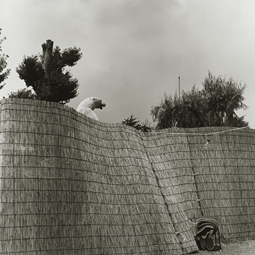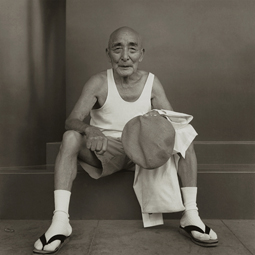 |
|
 |
| A man dressed in leather, 1985 |
|
A woman with a vast wardrobe who enjoys horse races, 2001 |
Hiroh Kikai is by no means an "underground" artist, but his work has somehow remained beneath the radar of Japan's rather incestuous photography scene. His subjects, too, appear to dwell precariously on the fringes of society. For the past 40 years Kikai has assembled a stunning oeuvre of monochrome portraits of people whose eccentricities and air of dauntless self-possession put the lie to the usual stereotypes about conformist Japan.
Kikai himself has done his share of living on the edge. Born in 1945 in the northern prefecture of Yamagata, he moved to Tokyo to attend university, but after graduation spent several years driving trucks and working on boats and in factories. An encounter with the photography of Diane Arbus inspired him to pick up a camera in 1969. Since then he has spent most of his career snapping the working-class neighborhoods of Tokyo, but he has also photographed extensively in India and Turkey.
 |
|
 |
Seta, Setagaya-ku, 1985
|
|
Asakusa, Taito-ku, 1985 |
Only lately has Kikai received some well-deserved recognition. Tokyo Portraits, a retrospective currently at the Tokyo Metropolitan Museum of Photography in Ebisu, is his first solo exhibition in a major gallery. The show actually combines two ongoing series. Of some 180 works on display, about 140 are portraits, mostly of passersby in Tokyo's Asakusa district. The remaining 40 are street scenes from various parts of Tokyo that are devoid of human presence -- what Kikai calls "portraits of spaces." He sees these projects as two sides of the same coin, and there is no denying that they complement each other nicely. Indeed, the abstract quality of the cityscapes offers a bit of a respite after one has digested a wallful of human visages of such intensity.
To understand Kikai's work, it helps to know a bit about Asakusa. Though the huge lantern hanging from the Kaminari-mon (Thunder Gate) of Sensoji temple is one of Tokyo's biggest tourist draws, the surrounding neighborhood is something of a backwater, an iconic example of the shitamachi lower city that has seen better days. Once a thriving entertainment center strategically located next to the Yoshiwara brothel quarter of ukiyo-e fame, Asakusa was Edo's, and then Tokyo's, mecca for plebeian pleasures. But today it is defined more by the presence of a huge off-track betting center and proximity to the Sanya flophouse district. Hence Asakusa seems to attract those who march to a different drummer from the rest of Tokyo, nonconformists not so much by choice as by fate.
 |
|
 |
| A chief carpenter, 1985 |
|
A young man who had walked here from far away, 1999 |
These are the people whose portraits Kikai has been shooting for the last forty years. His technique is simple. Carrying his trusty Hasselblad, the same camera he has used since 1976, he loiters near the back wall of Sensoji until he sees someone he wants to photograph -- as he puts it, "someone whose aura says 'take my picture, please.'" If they consent, he has them stand against the temple wall in a pose of their choice. Rarely does he shoot more than two subjects in a day, and sometimes he finds none.
Kikai's relaxed, even diffident approach pays off because his subjects clearly feel free to be themselves, and their expressions are often nonchalant, even defiant. These are folks who have dealt with some hard knocks in life. Many have devised novel techniques for survival, others appear to have not. In a few cases Kikai has photographed the same person twice or more over intervals of several years; most have aged quickly, and not well. Some are clearly homeless, some mentally damaged, but all exude a fierce individuality. They stare straight at the camera, daring the photographer -- and the viewer -- to ridicule or dismiss them.
 |
Installation view of Tokyo Portraits; the image at right is "An older man with a penetrating gaze," 2001.
Photo by Alan Gleason, by permission of the Tokyo Metropolitan Museum of Photography
All images © Hiroh Kikai, courtesy of Crevis |
To each portrait, Kikai has appended a brief but telling caption that sketches, in haiku-like fashion, a few pertinent details about the subject. Fortunately for non-Japanese visitors, these have been translated into English, because Kikai's notes are an essential gloss on the images. Some examples:
A man in an outfit coordinated in yellow, down to his shoes
A man who blinked very slowly
A man swearing under many layers of women's clothing
A woman who was giving cornflakes to the pigeons, bag and all
A lover of jazz and Japanese-style painting, wearing 10-yen coins as earplugs
A woman who told me she'd been raising a doll for 28 years
Her husband, who'd been living with the doll for 28 years |
The street scenes, on the other hand, are titled only by location and year. But these pictures speak for themselves. Some are geometric studies in angles and surfaces, but others are just as whimsical as the portraits -- is that a polar bear rearing up from behind a fence on an Asakusa backstreet?
The humor Kikai brings to his art is never cynical or derisive. Indeed, he has said that he shares his subjects' sense of being an outsider, not only in Tokyo but in the world at large. The greatness of Kikai's work lies in the fact that it transcends demarcations of city, class, culture or nation, and speaks volumes, in a universal language, about the human condition.
Kikai will be speaking at the museum on September 18 from 2 to 3 pm and on September 23 from 3 to 4 pm.